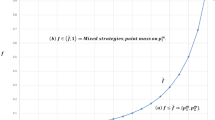Abstract
The model considers a seller operating under the threat of an arbitrarily large number of unknown potential entrants and facing a strategic buyer. It is shown that the seller's Nash best response function slopes downward in price-output space, while that of the buyer slopes upward. The Nash equilibrium may be associated with a lower probability of entry than the equilibrium at which the buyer behaves non-strategically. With the buyer as the Stackelberg leader, the price is shown to decrease relative to that at the Nash equilibrium, but the probability of entry may rise or fall.
Similar content being viewed by others
References
Baron, D.P., "Limit Pricing, Potential Entry and Barriers to Entry,"American Economic Review, 63(4) (1973): 666–74.
Boyer, M. and M. Moreaux, "Distribution des Roles et Espaces de Strategies dans la Theorie du Duopole de Stackelberg," (Distribution of Roles and the Space of Strategies in Stackelberg's Theory of Duopoly), Cahier 8318, Universite des Sciences Sociales de Toulouse, (1983).
Dixit, Avinash. "The Role of Investment in Entry-Deterrence,"Economic Journal, 90 (1980): 95–106.
Gaskins, D. "Dynamic Limit Pricing: Optimal Pricing Under the Threat of Entry,"Journal of Economic Theory, 3 (1971): 306–22.
Jacquemin, Alexis.The New Industrial Organization: Market Forces and Stategic Behavior, Cambridge, MA: MIT Press, 1987.
Kalish, L., H.J. Cassidy and J. Hartzog. "Potential Competition: The Probability of Entry with Mutually Aware Potential Entrants,"Southern Economic Journal, 44 (1978): 542–55.
Kamien, M.I. and N.L. Schwartz. "Cournot Oligopoly with Uncertain Entry,"Review of Economic Studies, 42 (1975): 125–31.
Kreps, D.M. and R. Wilson. "Reputation and Imperfect Information,"Journal of Economic Theory, 27 (1982): 253–79.
Imai, H. "Bilateral Price-Setting in a Bilateral Monopoly Model,"Mathematical Social Sciences, 12 (1986): 279–301.
Milgrom, P. and J. Roberts. "Limit Pricing and Entry Under Incomplete Information: An Equilibrium Analysis,"Econometrica, 50 (5) (1982): 1089–1122.
__ "Predation, Reputation and Entry Deterrence,"Journal of Economic Theory, 27 (1982): 280–312.
Roussas, G.A First Course in Mathematical Statistics, Reading, MA: Addison-Wesley, 1973.
Spence, A.M. "Entry, Capacity Investment and Oligopolistic Pricing,"Bell Journal of Economics, 8 (1977): 534–44.
Rosenthal, R. "Games of Perfect Information, Predatory Pricing and the Chain-Store Paradox,"Journal of Economic Theory, 25 (1981): 92–100.
Saloner, G. "Dynamic Equilibrium Limit-Pricing in an Uncertain Environment," M.I.T. Working Paper #342, (1984).
Author information
Authors and Affiliations
Rights and permissions
About this article
Cite this article
Mudambi, R. Entry deterrence: The case of a buyer with market power. Rev Ind Organ 5, 111–138 (1990). https://doi.org/10.1007/BF02284678
Issue Date:
DOI: https://doi.org/10.1007/BF02284678




